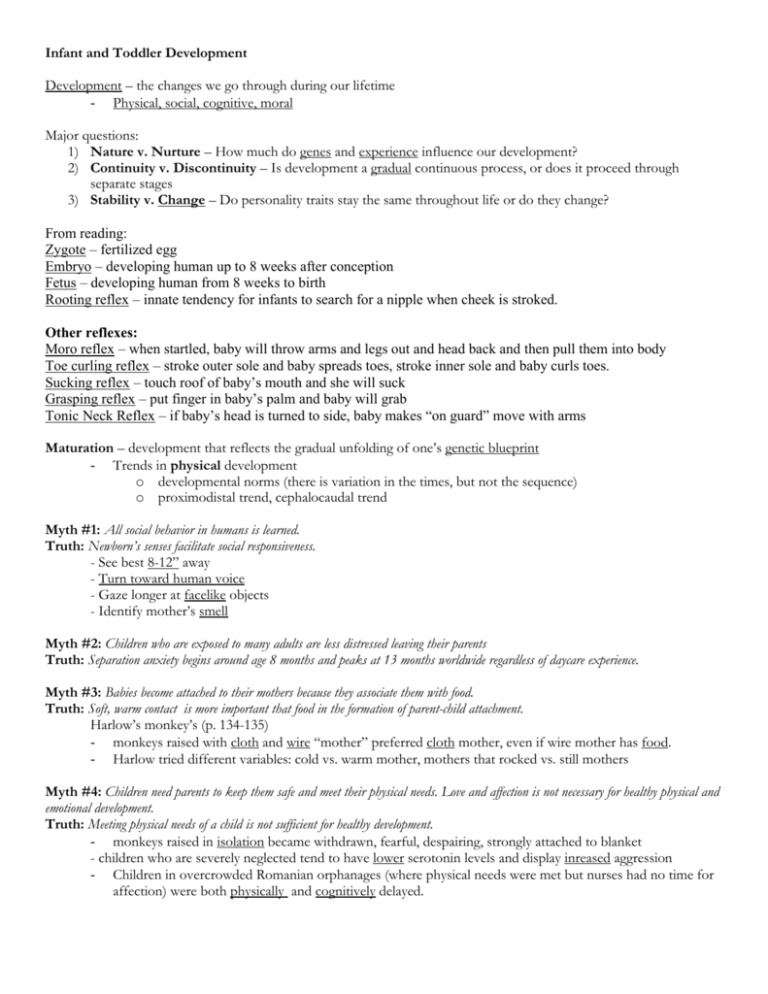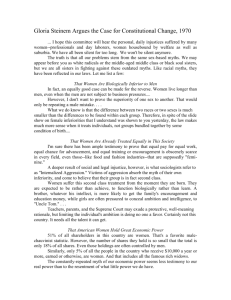Infant and Toddler Development
advertisement

Infant and Toddler Development Development – the changes we go through during our lifetime - Physical, social, cognitive, moral Major questions: 1) Nature v. Nurture – How much do genes and experience influence our development? 2) Continuity v. Discontinuity – Is development a gradual continuous process, or does it proceed through separate stages 3) Stability v. Change – Do personality traits stay the same throughout life or do they change? From reading: Zygote – fertilized egg Embryo – developing human up to 8 weeks after conception Fetus – developing human from 8 weeks to birth Rooting reflex – innate tendency for infants to search for a nipple when cheek is stroked. Other reflexes: Moro reflex – when startled, baby will throw arms and legs out and head back and then pull them into body Toe curling reflex – stroke outer sole and baby spreads toes, stroke inner sole and baby curls toes. Sucking reflex – touch roof of baby’s mouth and she will suck Grasping reflex – put finger in baby’s palm and baby will grab Tonic Neck Reflex – if baby’s head is turned to side, baby makes “on guard” move with arms Maturation – development that reflects the gradual unfolding of one’s genetic blueprint - Trends in physical development o developmental norms (there is variation in the times, but not the sequence) o proximodistal trend, cephalocaudal trend Myth #1: All social behavior in humans is learned. Truth: Newborn’s senses facilitate social responsiveness. - See best 8-12” away - Turn toward human voice - Gaze longer at facelike objects - Identify mother’s smell Myth #2: Children who are exposed to many adults are less distressed leaving their parents Truth: Separation anxiety begins around age 8 months and peaks at 13 months worldwide regardless of daycare experience. Myth #3: Babies become attached to their mothers because they associate them with food. Truth: Soft, warm contact is more important that food in the formation of parent-child attachment. Harlow’s monkey’s (p. 134-135) - monkeys raised with cloth and wire “mother” preferred cloth mother, even if wire mother has food. - Harlow tried different variables: cold vs. warm mother, mothers that rocked vs. still mothers Myth #4: Children need parents to keep them safe and meet their physical needs. Love and affection is not necessary for healthy physical and emotional development. Truth: Meeting physical needs of a child is not sufficient for healthy development. - monkeys raised in isolation became withdrawn, fearful, despairing, strongly attached to blanket - children who are severely neglected tend to have lower serotonin levels and display inreased aggression - Children in overcrowded Romanian orphanages (where physical needs were met but nurses had no time for affection) were both physically and cognitively delayed. Myth #5: Infants have a critical period for attaching to their caregivers (like the geese in Conrad’s imprinting studies). It is very important that mothers bond with their children in the first few hours of life. Truth: Although this is true with some bird species, it is NOT true in humans. Evidence shows that human children can form several attachments during their lives. Children who are separated from their parents initially exhibit symptoms of distress but recover if placed in a stable environment. Myth #6: Parents who respond every time their child cries reinforce crying behavior. It spoils them and makes the clingy mama’s boys. (Watson on parenting) Truth: Children of responsive mothers are more self-assured and less clingy that children of unresponsive mothers. Ainsworth study, p. 136 (“strange situations”) - observed mother-infant pairs at home- categorized parenting as sensitive or insensitive Later observed children in unfamiliar situation. 1. sensitive mothers had securely attached children (mom is safe base from which to explore, distress when mom leaves and seeks her contact when she returns) 2. insensitive mothers had insecurely attached children (cling to mom, distressed when mom leaves, and hard to console when she returns, some refuse mom’s comfort) According to Erik Erikson, this is because responsive mothers teach their child that they can trust them and the world around them. Thus, they feel confident and in control of their worlds. (Dr. Spock on parenting and the crazy sixties) Myth #7: Children do not bond with abusive or neglectful parents. Truth: Children even seem to attach to abusive parents. Harlow made “mothers” that hit the babies when the approached them. If the hitting mechanism was disrupted, the babies still preferred the familiar, formerly abusive mother to an unfamiliar mother. Myth #8 – Newborns are passive observers of their surroundings. They don’t understand concepts such as addition and subtraction. Truth: Infants as young as 5 months have demonstrated an understanding a simple subtraction (2-1=1) in habituation studies (p. 130, Figure 4.9) Question #1: Is it OK to put my child in daycare and go back to work? Answer: We don’t know. 1. Infants in daycare are more likely to be insecurely attached at 1 year old, and disobedient and aggressive at older ages. 2. In children 2 and over, daycare provides enhanced opportunities for intellectual and social growth. 3. Infants in quality daycare before 6 months were more outgoing, popular, and academically successful than those without such daycare. 4. Time spent in daycare between 1 month and 6 years correlates positively with mental development (at age three) and negatively with engaged mother-child interactions. Question #2: When does a baby figure out that he is the person in the mirror? Answer: About 18 months. Self-concept test (lipstick on the nose, see if she touches mirror or nose) Question #3: Is it better to be a strict or permissive parent? Answer: It is better to be somewhere in between. Three parenting styles: 1. Authoratarian – imposes rules, expects obedience 2. Permissive – few demands, little punishment, child gets his/her way a lot 3. Authoratative – demanding and responsive (establishes and enforces rules, but explains reason and allows for discussion when older) Children of authoritative parents have highest self-esteen, self-reliance, and social competence (true across cultures). Correlation does not mean causation, but thought that authoritative parents make children feel in control of their lives.







